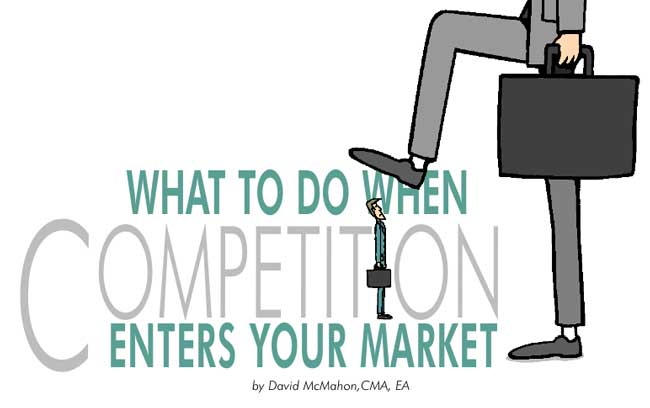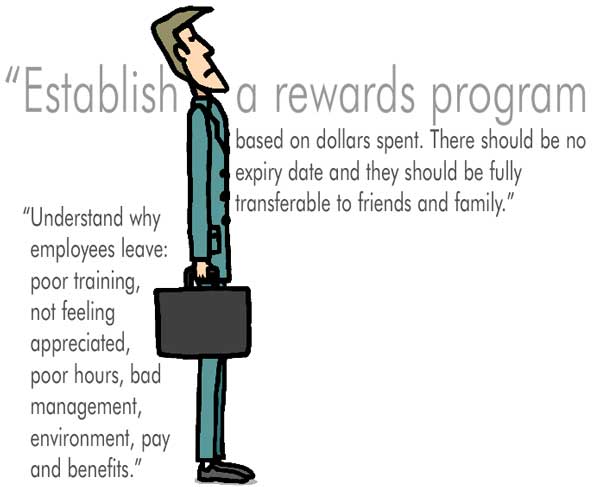
Expanding competition has been a common concern recently. Retailers across the country are asking what they should do to prepare for well known chain stores and others that enter their marketplaces.
First, stop worrying about what you can’t control. Next, start preparing for the inevitable.
Let’s suppose you have 500,000 people in your primary trade area. There are likely several stores already who directly and indirectly compete for your customer’s attention and disposable income. Those that compete directly against you are in the same market segment. You are likely selling a similar product and possibly a different mix or range of price (Ashley Furniture, Ikea Furniture, Restoration Hardware, and family owned store fronts, all compete directly). Those that compete indirectly are those that sell a different product altogether but ask for a similar investment (home improvement stores, furniture retail, and auto retailers all compete for the consumer dollar). Most vibrant regional markets have these various degrees of competition.
A direct competitor moving into your market may even be less of a threat than indirect competitors. It, at least, keeps the money in the family. A direct competitor will add buzz for what you sell. They sink marketing dollars and public relations investment into your region. An indirect competitor steers consumers’ disposable income away from your industry segment altogether.
Focus On What You Can Control
If you are a full line home furnishings retailer and a big box comes to your area, they will stir it up. After all, they are entering your market because they feel that it is worth their investment. This may be a good thing. Often times, the best place to be is where businesses are entering into a marketplace rather than leaving. If your marketplace is expanding, then congratulations – business minds believe there is growth potential in your area. This is normal in a healthy economy. These companies coming to town also believe that you and those like you cannot fill your market needs alone. They feel that there is a gap in your area that they can capitalize on. They probably believe that they can do a better job serving your market than you and your current competitors.
Hang On To Your Best Customers
The absolute worst thing that can happen when a direct competitor comes to town is that your best customers buy from them instead of you. Don’t let your customers, become, your competitor’s customers.
This is an area where you have control. It is easier and much less costly to keep existing customers than attracting new ones. This is where you have a distinct advantage. Your competition will try to entice your customers through various marketing initiatives. They will spend a lot of time and money in an attempt to lure buyers away from you. Knowing this, you can limit the effect that their solicitations have.
How to Prepare
Here are some ways to stop your new competitor from taking your customers.
1. Top 20% Contact. Realize this: The majority of your revenue and profit are produced by the minority of your customer base. These are the people you need to stay loyal to your brand. Do you know who these people are? Where they live? What they do? Are they just numbers in a database to you or have you really connected with them? If your salespeople cannot recognize their top customers on the street, then you are probably disconnected. Whether you are in touch with your best customers or not, you should seek to engage them on a routine basis to keep them from leaving you.
Open up the conversation. That doesn’t necessarily mean repetitively sending them anonymous direct mail pieces or mindless email blasts. You need to really connect. Pick up the phone. Send a hand written card. Compose a personal one-on-one email. Send flowers or tickets to the movies. Make something up that you would do for a good friend – be creative and show your appreciation. If you make a friend, you have a customer for life.
2. After Sale Contact. The truth is: most salespeople fail miserably at following up with their customers after they buy. Most salespeople (and their retail managers) are conditioned to focus on closing one customer then immediately move on to the next Up. They totally miss the huge upside potential for making subsequent sales from prior ones. They are oblivious of the notion of a lifetime customer.
Here is a true story: I have some clients that don’t spend much on self-promotion – under 3% of sales on advertising. These businesses are also some of the most profitable, producing over 15% net income, each year during the last 3 years. They have been able to do this because they provide a remarkable customer experience – before, during and after the sale. They personally keep in touch with all customers at various times: after the sale, before the delivery, during the delivery, right after the delivery, 3-6 months after delivery, and 1 year after. Many furniture retailers resist doing this because they believe they don’t have the time to do it, or feel that they will invite customer complaints. The fact is, however, that professional salespeople do make the time and don’t hide from their customers. Not making the time and hiding from customers are a sure fire way to hand customers to your new competition on a silver platter.
3. VIP Rewards Club. Customers frequent businesses that give them something extra of value back. Reward points have been proven successful in numerous industries. They are used by airlines, credit card issuers, sporting goods retailers, supermarkets, and countless others. Yet, in segments such as home furnishings retail, True Reward Clubs are not yet common. Establish a rewards program based on dollars spent. There should be no expiry date and they should be fully transferable to friends and family. Points must be just like real cash. Here is how it might work: For each one dollar spent, customers receive one point. You decide on what one point can buy. One point may be equal to 10 cents at retail, for example. That means that if someone spends $10,000 they have 10,000 points. That equals $1,000 of spend. This is 10%. Or, do what the retail chains like Performance Bicycles and REI do: Accumulate a 10% credit on all purchases to be used after 24 hours on a different product. This will help you build and keep customers.
4. Speak to Your Customers’ Needs. If you want a greater chance of re-selling your current customers, find out what their future needs are. Implement a next purchase system that keeps track of details about what customers may be interested in purchasing at a later time. Use this information as a targeted follow-up tool to increase the odds that your top customers will stay with you, instead of shopping your competition.
Make sure you have a working CRM (customer relation management) system that integrates with your POS (point-of-sale) system and that you know how to use it. Mining your customer data produces leads for salespeople and value for your customers.
5. Referral Programs. All customers have friends and family members who have not shopped with you before. By tapping into your customers’ personal networks you can encourage them to act as your promoters. Actual and social word of mouth are some of the most powerful and inexpensive marketing tools. Create a referral program that encourages people to talk about you. Examples might be a “Friends & Family” discount card or a “priority delivery time” in return for Facebook page posts. Be creative.
6. Improve on Product and Service Offerings That Your Customers Want. One reason why people may shop your competition is that they believe your competitor is offering something better. It might be faster service, a greater assortment of product, more enjoyable sales staff, a better price, or anything else. Well, it is hard to be all things to all people, but you need to decide on what you will be to your customers. Then you should seek to improve what you are. For example, if you have evidence that your customers shop with you because you have the highest quality wood products in your market, expand and improve on this offering. Then continuously communicate this important advantage. If a competitor enters your marketplace with something similar, you don’t need to change your strategy and become a price competitor.
7. Don’t Sell Commodities. If you sell generic me-too items, you will not be able to differentiate your product offerings in the minds of your customers. That may be fine if you have a big advantage over your new competition in terms of buying power and overhead, but if you don’t have this advantage, you will need a different strategy.
When a competitor comes to town it is important that you expand your line-up of suppliers to allow you to be different. You likely cannot compete long term selling the same products as a chain with 10 times the marketing spend and rock-solid business processes. Establish a loyal base of committed supply chain partners and have your own private label brand.
8. Keep Your Team on Board. The best teams usually win. Expect your new competitor to go after your best customers and perhaps your best salespeople as well. Understand the reasons why people leave: bad management, not feeling appreciated, poor training, poor work environment, they are not having fun, poor hours, poor pay and benefits. It’s a good idea to have management, schedule routine one-on-one sessions with the people they supervise to acknowledge good work, get feedback/ ideas, and provide helpful direction. If you expect your team to improve their communication skills with customers then you first need to ensure that you and your managers communicate better with your team.

If you can hang on to your best salespeople and further improve your team when a competitor enters the market, you will have the opportunity to grow your business.
Competition coming to your market is normal in a healthy, economy. You may all win, you may all lose, or some may win and some may lose. But your best strategy is to stop worrying about what you cannot control and start taking actions to improve the value you provide to your customers and the quality of the relationships you have with them.